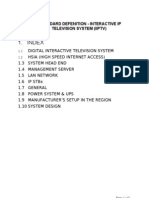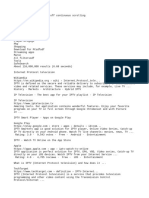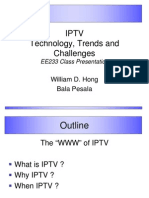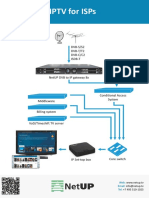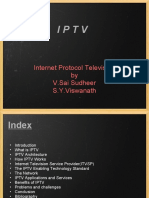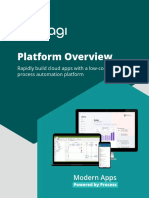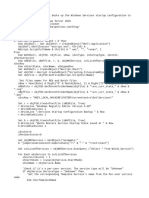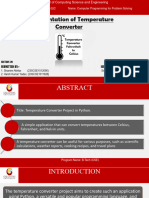Rekha Nair Asst - Profes Sor Kvvs It Adoor: Presented by
Rekha Nair Asst - Profes Sor Kvvs It Adoor: Presented by
Uploaded by
Rekha NairCopyright:
Available Formats
Rekha Nair Asst - Profes Sor Kvvs It Adoor: Presented by
Rekha Nair Asst - Profes Sor Kvvs It Adoor: Presented by
Uploaded by
Rekha NairOriginal Description:
Original Title
Copyright
Available Formats
Share this document
Did you find this document useful?
Is this content inappropriate?
Copyright:
Available Formats
Rekha Nair Asst - Profes Sor Kvvs It Adoor: Presented by
Rekha Nair Asst - Profes Sor Kvvs It Adoor: Presented by
Uploaded by
Rekha NairCopyright:
Available Formats
IPTV
Presented By
Rekha Nair
Asst.Profes
sor
KVVS IT
Adoor
IPTVDELIVERING TELEVISION TO CONSUMERS
IPTV is a method for delivering traditional, linear television programming to
consumers over a private IP network.
It can be considered a direct substitute for broadcast, satellite, or CATV
systems, because it accomplishes the same purpose delivering hundreds of
Channels of continuous programming that are displayed on a television
by way of an !T".
!ervice providers who wish to deliver multiple consumer services over a
single network often choose IP technology because a single platform can
provide voice and high#speed data access in addition to IPTV.
In a typical system, a private, high#speed IP network is used to deliver video
programming continuously to hundreds or thousands of viewers
simultaneously.
$igure %&#% shows a typical IPTV network.
CHARACTERISTICS OF IPTV
1) Continuous content stre!s
IPTV is designed to send streams of video programming to each viewer. These
streams are continuous' that is, each viewer can select the stream he or she wants
to view but must (oin the stream in progress.
") Mu#ti$#e c%nne#s
The primary content delivered over an IPTV network is produced by a range of
broadcast networks and delivered simultaneously to a large number of viewers.
Viewers typically choose which channel they want to watch on their television by
interacting with the IPTV set#top bo) *!T"+. This can be done simply by entering
the desired channel number on a remote control keypad or by making a selection
from an ,lectronic Program -uide *,P-+.
&) Uni'or! content 'or!t(
.ost IPTV systems use only one video encoding format *or possibly two+ for each
type of content. The choices typically range from .P,-#/ or .P,-#0 to VC#%.
IPTV providers will typically choose one compression format and one bit rate for
all !1 video signals and another combination for 21 signals. This greatly
simplifies the overall management of the IPTV system, allowing for a uniform
system design and easing the burden on technicians maintaining the system. This
also simplifies the !T" design by eliminating the need to support multiple video
decompression engines
)) Pri*te +e#i*er, net-or.( In order to deliver continuous channels of content to
thousands of viewers in a repeatable manner, an IPTV network must be carefully
provisioned and controlled. This task is very daunting on a private network, where
all of the video content and other network traffic can be controlled. This task
would be impossible on the public Internet.
/) Vie-e+ on consu!er te#e*isions *i set0to$ 1o2es The role of an !T" is
e)tremely important for an IPTV network. At a minimum, it must receive an
incoming IP video stream, reassemble the data packets in the correct order, decode
the video signal, and produce an output that can be fed to a television for display.
The !T" normally serves as the terminus for the IPTV network, so it must be able
to receive commands from the user3s remote control and send them into the
network for action.
APPLICATIONS
,ntertainment to the home
2otel4motel applications.
Entertin!ent
!ome very large IPTV networks have been installed to provide home video
services, similar to those provided by traditional CATV and 1T2 satellite
providers. In all these systems, individual households are supplied with a variety of
broadcast television channels in e)change for a monthly subscription fee. $ees pay
for three basic costs of the service provider
%. the cost of the programming,
/. the initial capital cost of installing the video delivery system,
&. The ongoing costs of performing maintenance on the delivery system and
providing customer service.
In many cases a license or franchise from the local government is re5uired to
operate the system' this may re5uire an annual fee to be paid to the government
*Called a franchise fee+. ,)clusive rights for a certain territory are sometimes given
to the service provider in e)change for certain concessions, such as providing
video services for governmental or educational use.
In any video delivery system, a number of potential subscribers will choose not to
receive video programming and become actual subscribers. The ratio of actual
subscribers to potential subscribers, called the take rate, can be influenced by a
number of factors.
6ormally, a service provider does not install all of the e5uipment needed to service
every single residence in a given area, because the take rate will begin at a low
percentage. Instead, distribution e5uipment is added as needed to handle new
subscribers as they sign up.
Hote#3Mote# Vi+eo Ser*ices
IP video technology can also be applied to delivering in#room entertainment video
to hotel guests. This technology can be used to provide all of the video services to
each room or (ust the premium movie channels offered by many hotels. "ecause
the video display in a hotel room is normally a television set, an IP#enabled !T" is
re5uired in each room to receive the incoming signals and convert them. Typically,
hotel systems are configured to use a video server in each building. The server
7utputs are connected to a data transport system that delivers the IP streams to
each room in the hotel. This can be accomplished via e)isting telephone wiring if
1!8 technology is used.
7ne advantage of IPTV in a hotel setting is due to the growing demand for
in#room Internet access.
9ith careful provisioning, it is completely possible to use the same in#hotel
1!8 circuits to deliver both data and video services to each room.
9ith many hotels upgrading their television systems to offer digital TV and
21 video services, IPTV becomes an attractive option.
In#room telephones can also be converted to voice over IP, but that trend is
not yet strong.
4ASIC CONCEPTS
5%, Use IP 'or Vi+eo to t%e Ho!e6
9ith the emergence of digital subscriber line *1!8+ technology, service providers
are now able to deliver thousands of kilobits per second of data to each customer3s
home. This capacity far e)ceeds what was possible even a decade ago, when
speeds were typically limited to a basic#rate I!16 line operating at %00 kbps or
a simple dial#up modem circuit operating at :; kbps. IPTV has often proven to be
the best choice for providing video over 1!8 circuits. "y adding IPTV, service
providers can earn additional revenue to help pay for 1!8 speed upgrades.
<ser control is another powerful trend in the video delivery business. "y enabling
users to choose what they want to watch at any time, service providers have been
able simultaneously to increase user satisfaction and increase the fees that
customers pay. $or e)ample, personal video recorders *PV=s, which have been
populari>ed by suppliers such as TiVo+ allow users to record television
broadcasts automatically on a computer hard disk for later, on demand playback
*sometimes called time shifting+. This service is not free <sers have to pay a
significant sum to purchase the PV= device and then many pay an additional
monthly service fee to receive the electronic program guide.
Another big market driver is convergence. "y convergence, we mean the use of a
single network to deliver multiple services to consumers. The term triple play has
come to mean the simultaneous offering of voice, video, and data services, all
billed to the subscriber in a single, convenient monthly package. "y offering
converged triple#play services, many providers are convinced that they can
increase customer retention and reduce the costs of their customer service
operations. "y making sure that their networks are fle)ible, service providers can
adapt to changing market demands while minimi>ing the cost of adding these new
services. IP networks have certainly proved to be one of the most fle)ible
technologies ever created and should remain that way due to the relentless march
of technology in the computer industry. IPTV takes full advantage of this
fle)ibility, making it easy for service providers to achieve a low#cost, multipurpose
service delivery network.
Vi+eo0on0De!n+
The basic concept of V71 is based on video programming that is stored and then
delivered to a viewer when it is re5uested.
7ne of the big controversies surrounding PV= service is the role of advertising in
recorded content.
Advertisers have two main concerns
Ad skipping, where viewers fast#forward through ads. This capability is often
listed as the motivation for many consumer PV= purchases.
Ad timeliness, where viewers watch programs at times far removed from their
original broadcast date. This is a big concern for advertisers who have their ad
campaigns targeted for specific time windows, such as promotional ads for a movie
being released to theaters the following day.
6etwork PV=s have e)citing potential to make advertisers much happier than
other PV= technologies. Consider what happens in a normal PV= scenario with an
advertisement. The machine faithfully records the commercials along with the
program content and gives the user the ability to fast#forward through any parts of
the program or advertisements at their whim. $or e)ample, say the viewer recorded
a program on 1ecember /? and decides to watch the program on 1ecember /@. As
you might imagine, the program contained a number of ads that pertained to
special last#minute shopping opportunities for Christmas. <nfortunately, when the
viewer watches the program, the sales are over and the ads are completely
worthless to both the viewer and the advertiser. 6ow consider the same scenario
with a networked PV= and some advanced technology in the server. 9ith this
technology, the service provider is able to replace the commercials in the original
program with ones that are timely and relevant whenever the viewer watches the
content. In our e)ample, the ads might be for something great to do on 6ew Aear3s
,ve, which the viewer might actually be willing to watch and for which an
advertiser might be willing to pay.
Table %&#% lists the most popular types of V71 services.
True *i+eo0on0+e!n+ 7VOD)
This is the purest form of V71, where each viewer receives an individual video
stream over which he or she has complete control.
Viewers are allowed to start, stop, pause, rewind, and fast#forward the content.
Viewers typically pay a fee for each title viewed' the charges are either debited
from a prepaid account or included on a monthly bill.
Ner *i+eo0on0+e!n+ 7NVOD)
!imilar to true V71, but without the individual video stream control capabilities.
7ne common form of 6V71 is sometimes called stagger casting,
!tagger casting in which multiple copies of a program are played starting at five#
minute intervals, thereby limiting any individual viewer to no more than a five#
minute wait before his or her program begins to play.
Su1scri$tion *i+eo0on0+e!n+ 7SVOD)
!ame delivery technology and viewer control as V71, but with a different
payment system.
In !V71, subscribers pay a fi)ed monthly fee for unlimited access to a
library of titles.
In many systems, the library is updated monthly.
Free *i+eo0on0+e!n+ 7FVOD)
A variation on V71 where payment is eliminated.
In most systems, this content is restricted to long#form advertisements, how#
to guides and other low#cost content.
,verything on demand *,71+ for some technology visionaries, this is the
ultimate form of video delivery system, where all programming is available
to all viewers at all times.
Person# *i+eo recor+ers 7PVRs)
These devices take incoming video programming, compress it, and record it
to a hard disk that is typically located either in an !T" or a stand#alone
device.
Viewers then control the PV= to play back content, including pause, fast#
forward, and rewind capabilities.
9ith this capability, also called time shifting, viewers normally program the
PV=s to record specific programs at specific times. 7ne of the pioneers of
this technology is a company called TiVo.
Net-or. $erson# *i+eo recor+ers 7NPVRs)
7ffers functionality similar to PV=s, but recording is performed inside the
service provider3s network rather than in the viewer3s location.
!ome content owners contend that this technology is so similar in capability
to true V71 that it needs to be licensed as such.
P, $er *ie- 7PPV)
This precursor technology to V71 is used primarily to deliver live paid
programming, such as concerts and sporting events.
Intercti*it,
Interactivity is like beautyBvery much in the eye of the beholder. "ecause of the
many different meanings that can be assigned to this word, let3s e)amine three
different ways in which viewers can interact with their televisions.
The most basic way those viewers interact with a television *basic
interactivity+ is to turn it on and off and to select a programming channel to
view.
In a typical broadcast, 1T2 satellite, or CATV system, this is a very simple
function to implement and can be completely controlled by e5uipment in the
viewer3s location, such as a TV tuner or a settop bo).
9ith the current generation of video over 1!8, there is usually only enough
network bandwidth to deliver one video signal per television.
This forces the channel#switching function to move out of the viewer3s
location and into the provider3s facility.
The e5uipment re5uired to implement this for a 1!8 system is a bit more comple)
than for a CATV system, as shown in $igure %&#/.
In this e)ample, the viewer interacts with his or her digital !T". 9henever he or
she wants to select a new channel, the viewer presses the appropriate command on
his or her remote control. The !T" takes this command and relays it to the digital
subscriber line access multiple)er *1!8A.+. As soon as the 1!8A. receives the
command, it locates the new content and begins sending it to the viewer. This is a
relatively simple process for broadcast channels, where the 1!8A. is already
receiving the content. The switch inside the 1!8A. is reconfigured to stop
sending one video channel to the viewer and to start sending another, typically by
way of an I-.P C8eaveD command followed by a CEoinD command
The ne)t#higher level of interactivity, VC=#like, occurs when viewers are given
the same set of controls they would have if they were operating their own personal
video cassette recorderBthat is, start, stop, pause, rewind, and fast#forward.
Implementing these functions puts a much higher burden on the video delivery
system, because each viewer needs to be supplied with a video stream that is
uni5ue to him or her and completely under his or her control. There are a number
of ways to achieve this functionality, as we discussed in the previous section, on
V71. 7ne thing that must be recogni>ed is that the amount of bandwidth needed
to provide V71 increases as the number of viewer3s increases. That is, as more
subscribers are added to a 1!8A., chances are more video bandwidth will be
needed to feed the 1!8A..
Content#oriented interactivity occurs when users are given the ability to respond
directly to the content itself. 7ne e)ample of this would be responding to an
advertisement by re5uesting more information or possibly even placing an order
for a product directly through a web interface on the television *a dream of many
infomercial vendors+. Another e)ample would be influencing the outcome of a
video program, such as voting for the winner of a talent contest during a live
broadcast and then seeing the results of the voting during the broadcast. 6ote that
for live content, the servers used for V71 do not come into play, because the
content must be distributed from the source directly to viewers without being
stored on servers. Instead, a mechanism must be provided to transmit the viewers3
commands or choices back to the origin of the broadcast. In the case of
prerecorded content with different program branches selected by the viewer
*similar to 1V1s with alternate endings+, the V71 server can simply treat each
branch of the content as a separate piece of content that can be selected by the
viewer, and the interactivity flows would terminate at the server.
The impact of these different levels of interactivity is presented in $igure %&#&,
which shows the data flows that occur in an IP#video over# 1!8 system under each
of the preceding scenarios. $or basic interactivity, the data flow starts at the user3s
remote control, passes through the set#top bo), and then moves to the 1!8A.,
where it terminates. $or VC=#like user control, the data starts out the same way
but ends up passing through the 1!8A. to video servers located further upstream.
9ith content interaction, the viewer responses are sent even further upstream, to
the content provider. It is possible that all these different data flows will need to be
accommodated in a single video delivery system, because individual subscribers
may choose different levels of interactivity.
O$ertions Su$$ort S,ste!s
A great deal of software is also re5uired for managing a huge array of tasks, from
informing customers about the programming available on the different broadcast
channels to capturing the data needed to bill subscribers for the services they have
purchased. Collectively, these software systems are known as 7perations !upport
!ystems *7!!+, and they can take many forms.
Table %&#/ lists many of the key functions provided by IPTV 7!! systems.
Fey 7!! $unctions for IPTV !ystems
1. An electronic program guide
It gives viewers the programming schedule for each broadcast channel and
available V71 titles.
This guide can be either a simple broadcast channel that scrolls through all
the program choices or an interactive program guide that allows the user to
navigate through listings, possibly to look at programming scheduled in the
future.
.any IPTV providers use outside companies to supply program guide data.
2. An order entry system is re5uired when customers are permitted to purchase
content through the IPTV system. This system needs to be able to verify that the
customer3s account information is valid and that the order can be filled as
re5uested. This system needs to connect to the subscriber billing system and may
also need to connect to e)ternal services for credit card validation, etc. A secure
*encrypted+ link is re5uired to customer homes when personal data is being
collected.
3. 7nline content access *e#mail, web surfing+ is provided by some IPTV
systems, allowing viewers to use their television sets for functions that might
otherwise re5uire a PC.
4. A subscriber management and billing system maintains crucial data about
each subscriber, including contact and billing details, account status, and
e5uipment identifiers.
IPTV DELIVER8 NET5OR9S
A wide variety of networks are used in delivering IPTV. There are the basic
delivery mechanisms, such as 1!8, passive optical networks *P76s+, and
traditional cable TV lines.
1igital !ubscriber 8ine *1!8+
Current#generation 1!8 technologies, such as asymmetric digital subscriber
line *A1!8+, provide relatively limited amounts of bandwidth from the
service provider to the consumer and even more restricted links from the
consumer back to the provider.
6ewer technologies, such as A1!8/ and A1!8/G, are being used for most
new installations, because they offer more bandwidth in the forward path.
V1!8 *very high#speed digital subscriber line+ technology supports
significantly more bandwidth on each subscriber line.
Accordingly, more video channels can be transmitted to each V1!8
subscriber, with three or four simultaneous videos possible.
A few high#definition video signals could also be transmitted.
7ne drawback to V1!8 is that the range of operational distances is less than
that for A1!8, so subscribers need to be closer to the service provider
facilities.
Also note that the speed of 1!8 services varies with distance, so good
planning for varying data rates is essential.
2./;0 technology has become critical for delivering 21 IPTV services,
because signal compression into the range of 0H%? .bps is re5uired for most
1!8 technologies.
Pssi*e O$tic# Net-or.s 7PONs)
IPTV technology can be used to distribute one or more video signals to a home
via the data portion of a P76.
9hen used in this manner, the IPTV system will look very much like the IPTV
system we discussed for 1!8 Individual channels will be re5uested by the
viewer at each !T", and the service provider3s IP network will deliver the
re5uested video channels. This system merely replaces the 1!8 link with a P76
data link.
Another alternative is a hybrid system. In this system, broadcast channels are
delivered by one wavelength of light in the P76 system, and the V71 and other
user#specific video channels are delivered via the data transport paths.
IPTV o*er C1#e
Traditional cable television *CATV+ networks have e)celled in the delivery of
hundreds of channels of video content simultaneously to thousands of users.
,ach user can select any one of the broadcast channels available, simply by tuning
a television or !T" to the correct channel.
These systems are easy to scale' adding new customers simply re5uires splitting
and amplifying the signal to reach more households.
Increasingly, CATV providers have begun to offer triple#play video, voice, and
data services. IP technology is a natural platform for converging these different
services.
!ome CATV providers are considering using IPTV over a standard CATV plant.
To make this operate, it is necessary to transmit IP data packets overthe cable
network.
S%re+ Dt Net-or.s
In many countries *for e)ample, Eapan, $rance, and Forea+, highspeed data
networks are already in place to serve individual subscribers.
Also, many businesses have high#performance networks installed to many
desktops.
In this situation, it is a relatively straightforward process to overlay IPTV on
an e)isting network that is shared with other data.
Ade5uate bandwidth is a key re5uirement for any type of video delivery
system. $or an IPTV system to work properly, each segment of the network must
have enough capacity to handle the total bandwidth of all the simultaneous video
streams passing over that segment.
.ulticasting is one way to reduce the amount of bandwidth needed.
In this case, the service provider3s *or the corporation3s+ networking
e5uipment fills the role of the 1!8A. for performing the multicast CEoinD and
C8eaveD commands re5uired for channel changing.
$or V71 and VC=#like interactivity, the network must have enough
bandwidth to handle the combined load of the individual streams.
It is 5uite feasible to implement IPTV services on a variety of different
shared networks.
TECHNOLOGIES FOR IPTV
Various technologies are re5uired to implement a practical IPTV system.
Content Processin:
Content#processing systems accept real#time video signals from a wide variety of
sources and shape them into a consistent format so that the customer !T"s can
decode the signals and display them on the viewers3 televisions.
Content processing can be performed on either a live stream or content that is to
be stored inside a video server for later playback.
9hen content processing is done on a live stream already in a digital format, the
process is called +i:it# turnroun+;
9hen this process is performed on content that is to be stored on a server before it
is delivered to viewers, it is called ingest.
This process also needs to capture the rules for using the content, such as limits to
viewing duration and permissions for downloading.
7ff#line ingest is used for content that is delivered in tape, disk, or file form, such
as 2ollywood movies.
Content Processor Functions
1. Compression $or analog video sources, digital compression is performed on
each video signal before it can be transmitted on an IPTV system. Items such as
peak video data rate and packet length are made consistent between all of the
different video sources to simplify the (ob of the transport and multiple)ing
functions.
2. Transcoding $or video sources already in a digital format, it is sometimes
necessary to convert the .P,- profile or level of the incoming stream to one that
is compatible with the !T"s. $or 21 content, it is standard procedure to change
.P,-#/ sources into 2./;0 to achieve lower bandwidths for 1!8 networks.
3. Transrating ,ssentially, transrating is the process of changing the bit rate of
an incoming digital video stream. $or e)ample, an !1 feed at 0.: .bps may need
to be reduced to /.: .bps for use in the IPTV system.
4. Program identification ,ach video stream needs to be uni5uely labeled
within the IPTV system so that multiple)ing devices and user !T"s can locate the
correct streams. ,ach audio or video program within each .P,- transport stream
must be processed to ensure that there are no conflicting PI1 numbers. If there are
duplicates, then one of the streams must be renumbered to a different PI1, and the
associated P.Ts must be updated.
Vi+eo0on0De!n+ n+ Vi+eo Ser*ers
The architecture of a typical V71 system that uses video#over#IP technology, as
shown in $igure %&#:.
There are four main components to a V71 system.
$irst, the content must be prepared for storage and delivery by compressing it
and *usually+ encrypting it on a content#preparation station.
A V71 server stores the content and creates the streams that are sent to
viewers.
,ach viewer has an !T" that receives the content, decrypts it, and generates a
signal to feed the viewer3s display.
The !T" also provides a means for viewers to order V71 services from the
fourth and final element of the system shownthe subscriber management and
conditional access system.
This subsystem takes commands from viewers, sends appropriate commands
to the V71 server, and delivers decryption keys to the !T"s.
Video servers are essential to any V71 system, because they create the actual
video streams that are sent out to each viewer.
These servers can range in si>e from very large to fairly small, and they can be
used for a variety of applications.
The amount of storage in a server can be large or small, and the number of
streams supported can be large or small.
These are not correlated' it is perfectly sensible to have a server with lots of
storage and little streaming capacity if it is being used to hold video content
that is only rarely viewed.
9hen purchasing a server, it is important to match the capabilities of the server
to the task that needs to be performed.
Video servers can be broken roughly into three categories
Production servers are used in the video production business, such as
television networks and postproduction houses. $or these customers, a video
server must handle a great deal of content, in a variety of formats, and
rapidly deliver files containing the content to user workstations when it is
needed. These servers typically do very little, if any, streaming. Instead, the
focus on these devices is large capacity and good support for content
searching' including tools that support the use of meta#data and that can
track multiple versions of files as content moves through the production
process.
Personal and corporate servers are used in environments where and the total
amount of content is relatively low, such as a training department of a medium#
si>ed corporation with a few do>en titles and less than :H%? simultaneous
viewers. This class of server can often be built with off#the#shelf components
on a PC chassis with speciali>ed software.
!ervice providers need specially designed servers capable of storing possibly
thousands of hours of content and delivering video streams to hundreds or
thousands of simultaneous viewers
7ne important constraint on a streaming video server is that end user devices
*!T"s+ have a precisely defined amount of buffer available.
If too much data is sent *causing a buffer overflow+ or too little the video
signal to the viewer will be interrupted.
To prevent this, the video server must be carefully designed to create
streams that are well behaved and won3t violate the buffer constraints.
!ervice providers use two main philosophies for server distribution in their
networks, as shown in $igure %&#;.
The first is centrali>ed, where large, high#capacity servers are installed in
central locations and the streams for each viewer are delivered over high#
speed communications links to each local service provider facility. T
he second is decentrali>ed, where smaller servers are located at each facility
and provide streams only to local viewers.
A central library server downloads copies of content to the distributed
servers whenever necessary.
7n one hand, the decentrali>ed concept makes sense because it helps to
reduce the amount of bandwidth needed between locations.
MHP n+ OCAP
.2P, which stands for .ultimedia 2ome Platform, and 7CAP, which
stands for 7penCable Application Platform, are both software interface
standards that have been developed for !T"s.
The 1igital Video "roadcasting *1V"+ Pro(ect, based in ,urope, developed
.2P' and Cable8abs, a (oint research and development group formed
by members of the CATV industry in the <nited !tates, developed 7CAP.
To a great e)tent, 7CAP is based on .2P. "oth are open tandards,although
some license fees may apply.
.2P functions as a standardi>ed interface for Cmiddleware.D It provides a
common interface between software applications and lowerlevel software,
such as operating systems and device drivers.
It does not provide user interfaces, but it does provide a platform on which
user interfaces can be built. It is not an operating system'
.2P greatly simplifies the task of application designers, by giving them a
uniform platform to build on.
This capability helps provide a greater market for these applications than
what would be available if the application was tied to the products of a
single !T" vendor.
.2P also simplifies the tasks of !T" vendors, because it allows them to
deploy applications written by third parties.
This can help reduce the software development costs for a new !T" and
allow products to reach the market more 5uickly.
7verall, .2P is designed to be a common interface for user interactivity
applications and !T"s, and gains in economy and efficiency should be
possible if this standard is widely adopted.
MHP A$$#iction E2!$#es
<ser interface for electronic program guide4interactive program guide
2ome shopping
Access to broadcast information servicesBnews, weather, financial
information *super#telete)t+
Video games
Applications synchroni>ed to video content, such as sports scores, play#
along games, audience voting4feedback
!ecure transactionsBhome banking
E2!$#es o' Resources A*i#1#e to MHP A$$#ictions
.P,- stream control
Te)t and graphics screen overlays
Video and audio clip playback
Program selector4tuner
Communication protocols *e.g., TCP, <1P+
Conditional access and encryption
<ser mouse4keyboard4infrared remote control access
Eava virtual machine scripting
.edia storage and playback controls
You might also like
- RS80A - v3.03.01 - v3.01.17 - Technical Note - Eng - 20211025Document22 pagesRS80A - v3.03.01 - v3.01.17 - Technical Note - Eng - 20211025Vicente RomanNo ratings yet
- IPTV Services DescriptionDocument52 pagesIPTV Services DescriptionNguyen Duy ThanhNo ratings yet
- 2.6.1.3 Packet Tracer - Configure Cisco Routers For Syslog, NTP, and SSH OperationsDocument2 pages2.6.1.3 Packet Tracer - Configure Cisco Routers For Syslog, NTP, and SSH OperationsLars Rembrandt50% (2)
- IPTV New 1Document60 pagesIPTV New 1Vamsi SharanNo ratings yet
- Iptv TutorialDocument9 pagesIptv Tutorialapi-3743192100% (8)
- 2011 Iptv PDFDocument62 pages2011 Iptv PDFEyob AberaNo ratings yet
- IPTVDocument11 pagesIPTVvenkateshmukharjiNo ratings yet
- Internet Protocol Tele Vision (IPTV)Document10 pagesInternet Protocol Tele Vision (IPTV)Harish KumarNo ratings yet
- IPTVDocument24 pagesIPTVSanjeev Goutam100% (1)
- IPTVDocument46 pagesIPTVശ്രീരാഗ് പി എം100% (1)
- IPTV PresentationDocument21 pagesIPTV PresentationHiren ChawdaNo ratings yet
- Internet Protocol TelevisionDocument11 pagesInternet Protocol TelevisionnejavmehtaNo ratings yet
- Iptv EditedDocument28 pagesIptv EditedSphurthi RaoNo ratings yet
- Tutorial On IPTV and Its Latest Developments: January 2011Document7 pagesTutorial On IPTV and Its Latest Developments: January 2011Prasad RaoNo ratings yet
- Internet Protocol Television by Deepak RaiDocument31 pagesInternet Protocol Television by Deepak RaiSurya6556No ratings yet
- Iptv I P T V: Nternet Rotocol Ele IsionDocument47 pagesIptv I P T V: Nternet Rotocol Ele Isionasifusmani19100% (1)
- Iptv Testing BookDocument118 pagesIptv Testing BookKeith Dawson100% (2)
- IPTVDocument18 pagesIPTVvaibhavgupta160No ratings yet
- IPTV CourseDocument674 pagesIPTV CourseNesa Vidojevic100% (2)
- IPTV Presentation - V2 PDFDocument47 pagesIPTV Presentation - V2 PDFFaizahKadirNo ratings yet
- IPTVDocument23 pagesIPTVAarjav Thakkar100% (1)
- Internet Protocol Television: Tek Nath Acharya 0215539Document24 pagesInternet Protocol Television: Tek Nath Acharya 0215539Tek NathNo ratings yet
- Opportunities in IPTV: Carolyn Wales Sukun Kim David Leuenberger William Watts Ori WeinrothDocument30 pagesOpportunities in IPTV: Carolyn Wales Sukun Kim David Leuenberger William Watts Ori WeinrothImran BalochNo ratings yet
- A Great IPTV Solution From ChinaDocument2 pagesA Great IPTV Solution From Chinahieu_cvnuNo ratings yet
- Mobile IptvDocument29 pagesMobile IptvManish PushkarNo ratings yet
- Module 3 - IPTV Architectures and ImplementationDocument57 pagesModule 3 - IPTV Architectures and ImplementationMladen VratnicaNo ratings yet
- Delivering IptvDocument32 pagesDelivering Iptvapi-3799915No ratings yet
- IPTVDocument18 pagesIPTVSarvesh PatelNo ratings yet
- How To Set Up A Network CameraDocument47 pagesHow To Set Up A Network Camerayoucheff mochammadNo ratings yet
- Restricts and Limiting Video Streaming With MikrotikDocument2 pagesRestricts and Limiting Video Streaming With MikrotikManoaMino100% (1)
- Internet Protocol Television: A Project Report OnDocument33 pagesInternet Protocol Television: A Project Report OnAkash KhandelwalNo ratings yet
- OTT Solution PDFDocument19 pagesOTT Solution PDFAsadur RahmanNo ratings yet
- Installing IP/TV Server: System RequirementsDocument8 pagesInstalling IP/TV Server: System RequirementsewrdietschNo ratings yet
- FTTH - New Business OpportunityDocument14 pagesFTTH - New Business Opportunitypoolmaster1987No ratings yet
- IPTV SpecificationsDocument13 pagesIPTV Specificationsqwsa1234100% (2)
- CCTV Installation ChecklistDocument6 pagesCCTV Installation ChecklistDavid BeechNo ratings yet
- NetUP IPTV BrochureDocument10 pagesNetUP IPTV BrochureTechne PhobosNo ratings yet
- IPTV Report PDFDocument43 pagesIPTV Report PDFAsif BelalNo ratings yet
- What Is Iptv and How It Works Part 4Document14 pagesWhat Is Iptv and How It Works Part 4ousamaNo ratings yet
- TV Turk Live Business Plan ENGDocument13 pagesTV Turk Live Business Plan ENGminervadeaNo ratings yet
- Iptv The Future of Television 1245 3Document41 pagesIptv The Future of Television 1245 3Preeti Singh100% (2)
- Analog vs. IP Technologies: Analog Security Camera System DesignDocument5 pagesAnalog vs. IP Technologies: Analog Security Camera System DesignAbdul RafaeNo ratings yet
- Access Control BrochureDocument12 pagesAccess Control BrochureNinz OftanaNo ratings yet
- Iptv Technology, Trends and Challenges: William D. Hong Bala PesalaDocument34 pagesIptv Technology, Trends and Challenges: William D. Hong Bala PesalaFelipe MarizNo ratings yet
- Evolution of TV Migration To The CloudDocument20 pagesEvolution of TV Migration To The CloudJesús Alberto SalazarNo ratings yet
- Iptv For Isps: DVB-S/S2 DVB-T/T2 DVB-C/C2 Isdb-TDocument4 pagesIptv For Isps: DVB-S/S2 DVB-T/T2 DVB-C/C2 Isdb-TCarlos CNo ratings yet
- Video Technology Report - REV4Document4 pagesVideo Technology Report - REV4Roman SohorNo ratings yet
- Protocols in IPTVDocument36 pagesProtocols in IPTVManish Das83% (6)
- The Best Network MonitoringDocument52 pagesThe Best Network MonitoringZlatko ArnoldNo ratings yet
- Video On DemandDocument8 pagesVideo On DemandSnapeSnapeNo ratings yet
- Netris Solutions For IPTV, OTT and Hybrid TVDocument12 pagesNetris Solutions For IPTV, OTT and Hybrid TVRaúl InfanteNo ratings yet
- FiberplanitDocument4 pagesFiberplanitJoel TorresNo ratings yet
- The Impact of Internet Protocol Television and Comparison With The Conventional TVDocument5 pagesThe Impact of Internet Protocol Television and Comparison With The Conventional TVElda StefaNo ratings yet
- IPTVDocument18 pagesIPTVAkash KhandelwalNo ratings yet
- Internet Protocol Television by V.Sai Sudheer S.Y.ViswanathDocument29 pagesInternet Protocol Television by V.Sai Sudheer S.Y.ViswanathViswanath SyNo ratings yet
- WPaper ServiceQuality AngDocument6 pagesWPaper ServiceQuality AngchuperchuyNo ratings yet
- Seminar Report IPTVDocument19 pagesSeminar Report IPTVvaibhavgupta160No ratings yet
- Internet Protocol Television Seminar ReportDocument34 pagesInternet Protocol Television Seminar Reporttripsabhi08100% (5)
- IPTV (Internet Protocol Television) Is A SystemDocument6 pagesIPTV (Internet Protocol Television) Is A SystemGP GILLNo ratings yet
- White Paper: An Introduction To IPTVDocument11 pagesWhite Paper: An Introduction To IPTVCindy MaldonadoNo ratings yet
- IPTV-Internet Protocol Televsion: December 2011Document62 pagesIPTV-Internet Protocol Televsion: December 2011Ermin SehicNo ratings yet
- IPTV-Internet Protocol Televsion: December 2011Document62 pagesIPTV-Internet Protocol Televsion: December 2011Nasida SelimajNo ratings yet
- PROJECT Report EndDocument36 pagesPROJECT Report EndPankaj RoswalNo ratings yet
- Bizagi Platform OverviewDocument13 pagesBizagi Platform OverviewSANDY BRILLITH LIZANA ROJASNo ratings yet
- Network Security Testing - CoreDocument2 pagesNetwork Security Testing - Core7h3rAmNo ratings yet
- HA030554 - 9 Nanodac PDFDocument392 pagesHA030554 - 9 Nanodac PDFdavescott6701No ratings yet
- Privacy-Enhancing Cryptography To Complement Differential PrivacyDocument6 pagesPrivacy-Enhancing Cryptography To Complement Differential Privacybela belaNo ratings yet
- Practice Week 4: Requirements: Students Create A New Folder W4 - Name - ID in The Drive E:/ To Save FilesDocument2 pagesPractice Week 4: Requirements: Students Create A New Folder W4 - Name - ID in The Drive E:/ To Save FilesTrần Thanh NguyênNo ratings yet
- Nama: Rismawaty (Maksi-39/AUD) Ringkasan Chapter 11 Data Visualization and Geographic SystemsDocument1 pageNama: Rismawaty (Maksi-39/AUD) Ringkasan Chapter 11 Data Visualization and Geographic SystemsrismawatyNo ratings yet
- 04 Sp20 UML Collaboration DiagramDocument31 pages04 Sp20 UML Collaboration DiagramHammad Ur RehmanNo ratings yet
- Face Detection and Tracking Using Live Video Acquisition - MATLAB & Simulink Example - MathWorks IndiaDocument5 pagesFace Detection and Tracking Using Live Video Acquisition - MATLAB & Simulink Example - MathWorks IndiarppvchNo ratings yet
- Regback VbsDocument3 pagesRegback VbsrossrecoverykayeNo ratings yet
- WMC SyllabusDocument3 pagesWMC SyllabusMona AggarwalNo ratings yet
- Analog To Digital ConversionDocument40 pagesAnalog To Digital ConversionKarthikeyan TamilselvamNo ratings yet
- Fundamental Data Types: Slides by Donald W. Smith Final Draft Oct. 15, 2011Document65 pagesFundamental Data Types: Slides by Donald W. Smith Final Draft Oct. 15, 2011Jad Antonios JelwanNo ratings yet
- Ch1 (CSE417)Document46 pagesCh1 (CSE417)mahfujur752No ratings yet
- Citra Log - Txt.oldDocument2 pagesCitra Log - Txt.oldNsiqnqbdjwnqNo ratings yet
- Day 3.2 - UML (Unified Modeling Language) - Case StudyDocument13 pagesDay 3.2 - UML (Unified Modeling Language) - Case Studyvthh94No ratings yet
- Unit 1 - HCI Assignment LecturesDocument165 pagesUnit 1 - HCI Assignment Lecturesm39004179No ratings yet
- ANSYS 10.0 Workbench Tutorial - Exercise 4, Remote and Combined LoadsDocument42 pagesANSYS 10.0 Workbench Tutorial - Exercise 4, Remote and Combined Loads72alfettaNo ratings yet
- (ST) UGW9811 V900R010C00 ST v1.5Document34 pages(ST) UGW9811 V900R010C00 ST v1.5John Cristouv CortezNo ratings yet
- Laptop Mayo 2020Document1 pageLaptop Mayo 2020Oscar Casani DurandNo ratings yet
- 1760 Presentation Circuitcam Circuit Board Plotter PDFDocument6 pages1760 Presentation Circuitcam Circuit Board Plotter PDFTiffany TaylorNo ratings yet
- JDE A73 Tech Foundation PDFDocument505 pagesJDE A73 Tech Foundation PDFANISHNo ratings yet
- R2doc TutorialDocument36 pagesR2doc TutorialTrina MillerNo ratings yet
- Birla Institute of Technology & Science, Pilani Work Integrated Learning Programmes DigitalDocument16 pagesBirla Institute of Technology & Science, Pilani Work Integrated Learning Programmes DigitalGaurang PrajapatiNo ratings yet
- A029L290 (Issue 11) PDFDocument82 pagesA029L290 (Issue 11) PDFMárcioHenriqueNo ratings yet
- Talend Activity Monitoring Console: User GuideDocument40 pagesTalend Activity Monitoring Console: User GuideBhanu PrasadNo ratings yet
- PPS PPT (Harsh Yadav and Shamim Akhtar)Document10 pagesPPS PPT (Harsh Yadav and Shamim Akhtar)ђarຮђ ψaᖙavNo ratings yet


































